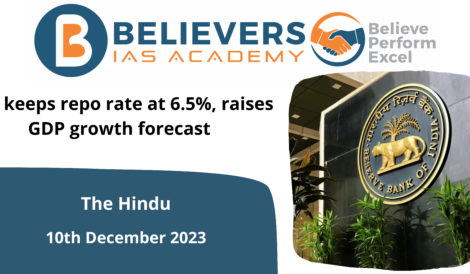Economy grows 7.8%, fastest in 4 quarters
Context
GVA from trade, lodging, transportation, communications, and broadcasting services increased 9.2% in Q1, while GVA from finance, real estate, and professional services increased 12.2%. The employment-intensive construction sector, public administration, defence, and other services all had increases in GVA of 7.9%.
What is GDP?
- The entire monetary worth of all goods and services produced inside a nation’s borders during a certain period is known as the Gross Domestic Product or GDP. It is a comprehensive indicator of a nation’s economic health.
- The following equation is used to compute GDP: GDP = private consumption + gross private investment + government investment + government spending + (exports – imports).
- Typically, a nation’s national statistical agency will calculate GDP.
- India’s GDP increased by 7.8% in the April to June 2023–2024 quarter. Domestic consumption and investment growth drove this increase, which was a one-year high. India’s economy continued to grow at the quickest rate among developed nations thanks to improved performance in the banking and agricultural sectors.
What is GVA?
- The value of the goods and services generated in an economy is measured by the macroeconomic indicator known as Gross Value Added (GVA). It is the total cost of all output produced, excluding any production-related intermediary costs. A crucial factor in determining the economy’s GDP is GVA.
- GVA is computed by subtracting the value of intermediate inputs from the total value of output. Raw materials and other products and services used in the production process are considered intermediate inputs.
- The GVA formula is: GVA=GDP-Taxes+Subsidies
- Without taking into account the effects of taxes and subsidies, GVA offers a more realistic representation of the actual value produced by various industries and economic sectors.
What is the difference between GDP and GVA?
Gross Value Added (GVA) and Gross Domestic Product (GDP) are two crucial economic metrics that shed light on a nation’s overall economic performance. Although they are related ideas, there are some significant distinctions between them:
Gross Domestic Product (GDP):
- The gross domestic product (GDP) is the total monetary worth of all finished products and services produced within a nation’s boundaries over an extended period (often a quarter or a year).
- The value of the goods and services produced by all economic sectors, including domestic and international businesses operating within the nation’s borders, is included.
- Three methods can be used to calculate GDP: the production method (which adds up the value added by each industry), the expenditure method (which adds up consumption, investment, government spending, and net exports), and the income method (which adds up all incomes from factors of production like wages, profits, and rents).
Gross Value Added (GVA)
- GVA is a measure of the overall value created by an economy’s various production-related sectors.
- It is computed by taking the total output of products and services produced in a specific sector and subtracting the value of intermediate consumption (cost of inputs).
- By removing the double-counting of intermediate inputs that are prevalent in GDP calculations, GVA provides a clearer view of the contribution of each sector to the economy.
- GVA is a tool for assessing a sector’s overall economic performance, and it is frequently combined with other sectors to calculate GDP.
How is India’s economic performance in the first quarter of the financial year?
- Growth in GDP and GVA: In the first quarter of the current fiscal year, India’s GDP and Gross Value Added (GVA) both grew by 7.8%, which is a four-quarter high. A measurement of economic output known as GVA growth accounts for the value added at each step of manufacturing.
- Growth-Affecting variables: According to economists, several variables could potentially slow down the rate of growth for the rest of the fiscal year. A bad monsoon, high inflation, and potential threats to the global economy all affect India’s growth trajectory.
How did each sector perform in the first quarter of the financial year?
- Manufacturing: After experiencing a period of decline, the manufacturing sector showed indications of recovery by expanding for the second straight quarter. In the first quarter, the growth rate improved marginally from the fourth-quarter level of 4.5% to 4.7%.
- Agricultural: Between April and June, the forestry, agricultural, and fishing sectors all grew by 3.5%.
- Services: The largest growth spike was seen in the services sector, which made a major contribution to the total projections. Financial, real estate, professional services, trade, hotels, transportation, communication, broadcasting-related services, public administration, defence, and other services are some of the major service sectors that saw significant expansion.
Conclusion :
Overall, the 7.8% growth rate in India’s GDP and GVA during the first quarter is seen favourably, although economists disagree on whether this growth rate will continue throughout the rest of the fiscal year. The trajectory of India’s economic growth in the upcoming months will be influenced by several variables, including the performance of various sectors and foreign problems.





